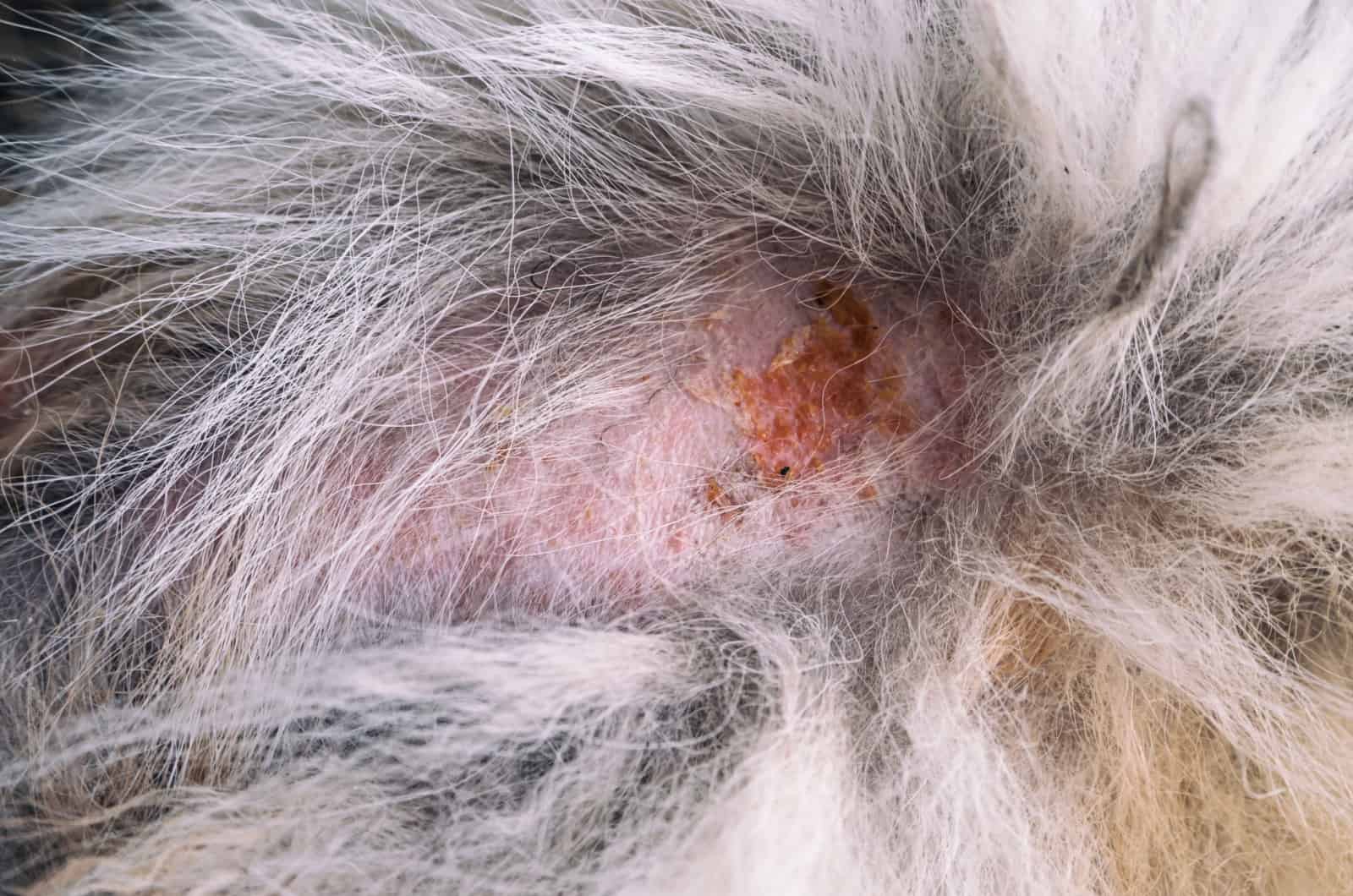Regular brushing and bathing of the dog mean that the dog owner takes care of his furry friend’s health and keeps his fur shiny and clean.
Brushing and bathing is also an opportunity to check if there are any wounds, scratches, or other changes on our dog’s fur and skin.
Such changes in a dog’s skin can look ugly and sometimes even scare us. But are sores or scabs a sign of alarm? What could crusty scabs on dogs back mean?
If you just noticed the scabs on your dog’s back, do not panic immediately. You first need to find out what could have caused this, so, keep reading to discover why this change in dogs’ skin can occur.
We will also investigate whether this condition can be dangerous for the dog and whether there is anything you can do to help your pet.
What Causes Crusty Scabs On Dogs Back?
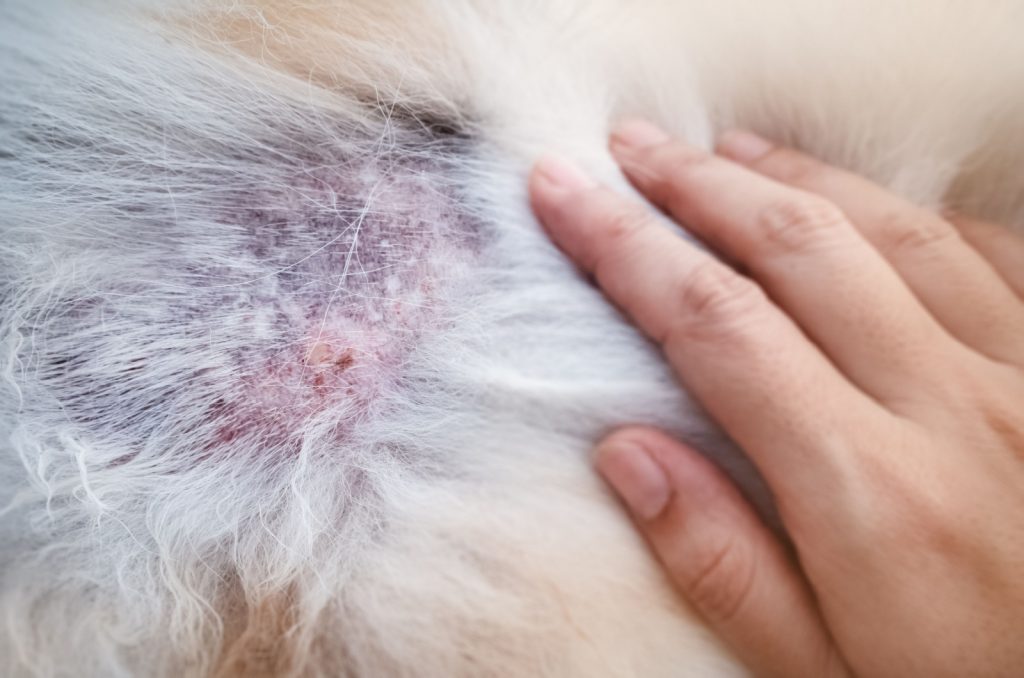
To be able to treat a certain skin change, the crucial step is to determine the exact cause of your dog’s condition.
So, a good way to start is by reading our following list. This list provides you with the common causes of crusty scabs on a dog’s back.
1. Wrong Nutrition
Nutrition is a vital segment of a dog’s overall health. A healthy and high-quality diet will also be visible on your dog’s fur, which will be healthy and shiny.
On the other hand, if the food you are feeding your dog is not the best choice for your pooch, you may notice this on your dog’s skin. Your dog’s fur and skin may become stiff and cracked and may begin to look lifeless.
Therefore, crusted scabs on the dog’s back could indicate that your dog’s diet lacks protein and nutrients. If you are unsure why your dog does not like the dog food you are feeding it, it would be best to consult a veterinarian.
He might recommend changing your dog’s diet entirely or adding some supplements to your dog’s nutrition.
2. Allergies

Allergies can be the reason for the appearance of scabs on your dog’s back.
Dog allergies can be divided into skin allergies, food allergies and environmental allergies. Skin allergies, also called Allergic Dermatitis, are the most common, and fleas most often cause skin allergies in dogs.
Allergic reactions to food in dogs can be recognized by symptoms such as scabs on a dog’s body, itching, and gastrointestinal problems, such as diarrhea and vomiting.
Environmental allergies can also cause atopic dermatitis or crusty scabs in dogs. These allergies occur when a dog inhales allergens inside the house or outside. Environmental allergens include dust, dust mites, pollen, etc.
There are some common symptoms that you will notice in your dog, no matter what type of allergies he is dealing with. Those are crusted scabs, itching, frequent sneezing, and swelling of the dog’s face and lips, and the dog may constantly lick.
Make sure to take your dog to the vet for allergy testing to make sure these crusty scabs are caused by allergies.
3. Improper Hygiene
Bathing is essential in the hygiene of every dog, so probably every dog owner has once asked themselves: How often should I bathe my dog?
There is no universal answer to this question. This will significantly depend on the dog breed, as well as what your dog’s lifestyle is like. Some dogs will need bathing every three to four weeks, while for some others, a bath two or three times a year will suffice.
But, it is not only vital that you know how often you need to bathe your dog; it is also essential that you also know how to clean your dog.
Improper hygiene can cause the appearance of crusty scabs on your dog’s back.
The shampoo you use on your dog should be dog shampoo, not human, and the pH balance is different for dogs and humans. Therefore, products that humans use should not be used on dogs.
If you are unsure which shampoo would suit your dog best, find good options on our list of shampoos for all types of dog fur, which also smell great!
Here we will point out that many dog owners make one mistake when bathing their pets; bathing them too often. If you bathe your dog too often, you may be removing the natural protective layer on its skin, which then results in scabies.
4. Bacterial Infection
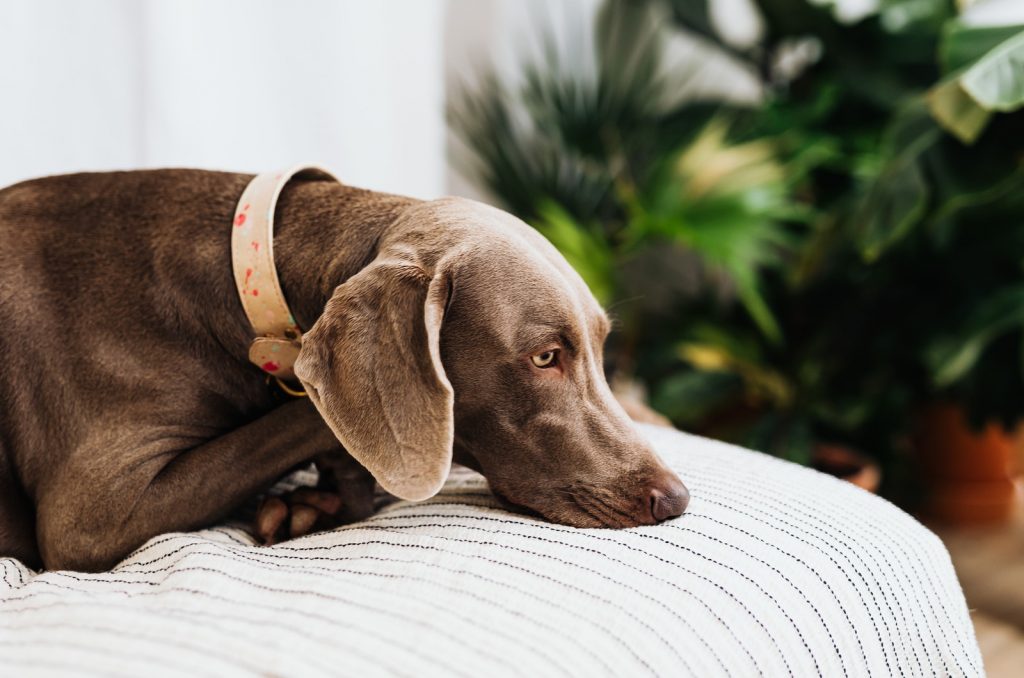
One of the possible causes of crusty scabs on a dog’s back is a bacterial infection. The most common bacterial infection is Folliculitis.
You will notice pus blisters if the dog suffers from this bacterial infection, and these blisters soon burst and turn into crusted scabs. There are various causes of this bacterial infection, the most common of which are flea allergy or food allergy.
5. Fungal Infection
Peeling scabs could indicate a fungal infection or ringworm in the dog.
Fungal infection can occur as a result of contact with another infected animal, but also due to too frequent bathing of the dog, as well as exposure of the dog to a humid environment for a long time.
A fungal infection can be identified by the dog scratching constantly and shedding hair from areas of the body that are affected by the fungus. In addition, inflammation, redness, and scabs will occur.
6. Yeast infection
Yeast infections in dogs develop due to an unbalanced immune system and are encouraged by medications and hot weather. This kind of infection can be noticed by the dog’s red and irritated skin, and the dog will also constantly scratch and lick itself.
In some cases of yeast infection, veterinarians advise changing the diet, and in others, the use of oral medications.
It is also recommended to treat the dog’s skin with anti-fungal shampoos or a cream containing benzoyl peroxide.
See Also: Can You Use Head And Shoulders On Dogs? Detailed Explanation
7. Hormonal Problems
Hormonal imbalance in dogs can cause skin changes. So, if you have noticed scabs on your dog’s back, this may be a problem that comes from within and is a hormonal disorder.
Such skin problems in a dog can be associated with hormonal diseases, such as hypothyroidism or Cushing’s disease.
Additional symptoms you may notice are hair loss, and the dog might drink more water and pee more frequently.
Also, you may notice that the dog’s skin has acquired a different pigment.
8. External Parasites

Most dogs will struggle with external parasites at least once in their lives. Not every parasite is equally dangerous for a dog, but one thing is sure – every parasite is irritating and makes our dogs feel uncomfortable.
The most common external parasites are fleas. Typical symptoms of this external parasite are itching and hair loss in the dog. Additionally, the dog is likely to constantly lick and scratch, causing crusty scabs and hot spots on its body.
Also, affected areas can become infected with bacteria, too, which can cause secondary infections.
If you notice flea bites in your dog, you should contact your vet right away. A flea infestation might lead to more severe health issues, like blood loss.
Besides fleas, mites are an additional common external parasite that attacks dogs.
Demodex mites cause demodectic mange in dogs, while mange mites cause sarcoptic mange. Demodectic mange is not contagious and cannot be transmitted to humans, while sarcoptic mange can.
See Also: How To Get Rid Of Mites On Dogs? — 11 Solutions9. Autoimmune Disease
Autoimmune diseases are incurable diseases of the dog’s immune system. Autoimmune means that the dog’s immune system attacks its cells. Such immune disorders are manifested in the form of acute skin ulcers.
Dogs’ most common immune disorders are hypothyroidism, lupus, and anemia. Autoimmune diseases can be pretty difficult to recognize but also to treat.
Some dogs are genetically more prone to developing such diseases; in some, the disease can occur due to consuming some medicine.
Of course, the earlier the disease is detected, the better it is for diagnosis and treatment. Therefore, every dog owner should thoroughly check their dog’s hair and skin regularly.
10. Skin Tumor
Unfortunately, crusted scabs can sometimes indicate a skin tumor in a dog.
Along with these skin changes, you can also notice changes in the dog’s behavior, so the dog might look tired all the time.
This is a severe skin condition that needs to be treated with surgery, radiation, or chemotherapy.
How To Help A Dog With Crusty Scabs?
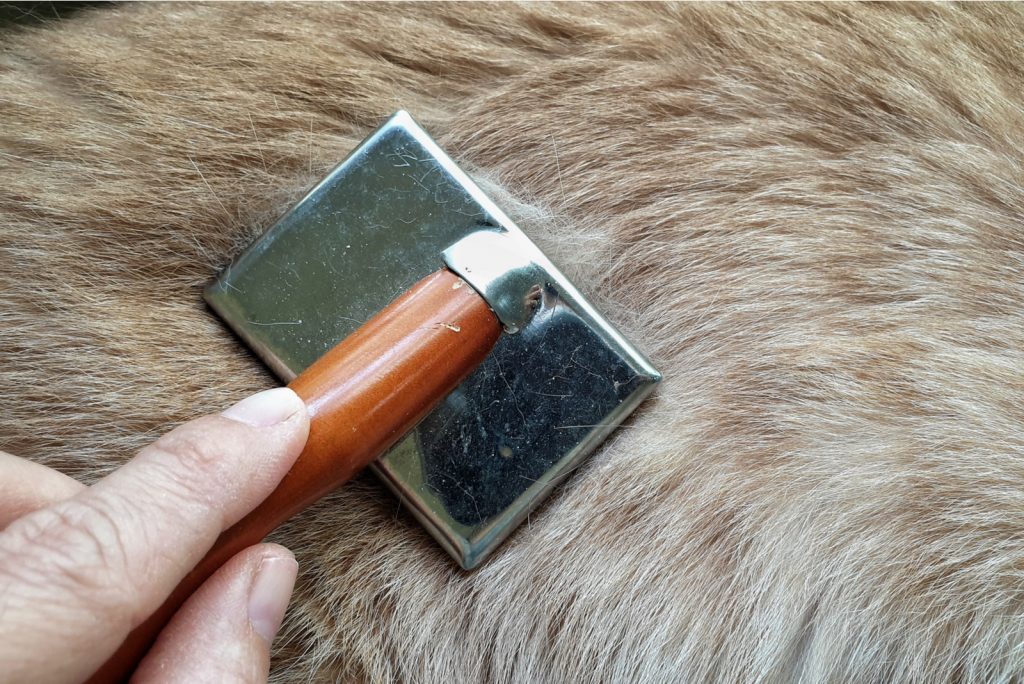
Skin changes in a dog can indicate various health conditions. Some are beyond your direct control, but there are specific steps every responsible dog owner can take.
Let’s learn a little more about them.
1. Grooming Is Important!
By regularly brushing your dog, you keep its fur tidy, and you can get rid of dirt on it. Also, brushing gives you insight into your puppy’s skin condition. If you brush your dog daily, you will probably immediately notice any change in the dog’s skin or fur.
Along with brushing, regular bathing is just as important.
A dog owner should determine the frequency of bathing according to the dog breed and its need. Another critical factor is whether the dog lives inside or outside and how much it generally gets dirty.
There are some changes in your dog’s skin that you can see with your naked eye, and, in this way, you can catch a skin lesion in your dog right at the start.
2. Balanced Diet

Balanced and high-quality food is the key to your dog’s health. Dry skin, skin full of sores or scabs, and the lifeless appearance of your dog’s fur could indicate that you have not chosen the right food for your dog.
Also, crusty scabs might indicate a lack of Omega-3 and Omega-6 fatty acids in your dog. Dog food should contain these fats.
Fish oil and lean meat are good sources of Omega-5 fatty acid. When it comes to Omega-3 acids, they can be found in food such as cold water fish.
It would be best if you took care that your dog gets top-quality food and the optimal amount of food – neither too much nor too little.
Choosing the right dog food can be challenging, so it would be best to consult a veterinarian if you have difficulties. In addition, our article on the worst brands of dog food can help you know which food you should avoid.
2. Home Remedies
There are also specific home remedies that you can use to help relieve your pooch’s itchy skin. For example, coconut oil can do miracles for your dog’s skin.
This oil has a beneficial effect on the dog’s hair follicles, and, by applying this oil, the dog’s skin will look healthier, break less, and be moisturized.
In addition, coconut oil is not harmful even for oral use. Therefore, you will not have to worry if the dog licks itself after smearing the dog’s coat with coconut oil.
Still, paying attention to the side effects of using this oil on your dog is necessary. You should contact your vet immeadiately if you notice an allergic reaction.
If you are wondering can you use some of the human medication on your dog, such as Neosporin – you might, since this ointment is beneficial in treating cuts, burns, or scrapes.
However, this medication is formulated for humans, not for animals. So, before applying this ointment or any other kind of ointment or cream such as Sudocrem on your dog’s skin, check with your vet first.
3. Keep Your Dog’s Environment Clean
Maintaining our dog and the environment in which he lives is essential for his overall health. In addition to dogs needing to be bathed and brushed regularly, it is necessary to pay attention to the places where your dog spends the most time.
Make sure you always clean up your dog’s feces, whether in your yard or for a park walk.
We know that dogs are no strangers to behavior such as licking the pee or poop of other dogs, and various diseases are transmitted in this way. Therefore, dog owners should be responsible and always clean up their pet’s excrement.
In addition, make sure to regularly clean your dog’s bedding, as well as his toys and food and water bowls. In this way, you significantly prevent the occurrence of bacterial infections that can cause skin infections on your dog’s body.
4. See A Vet
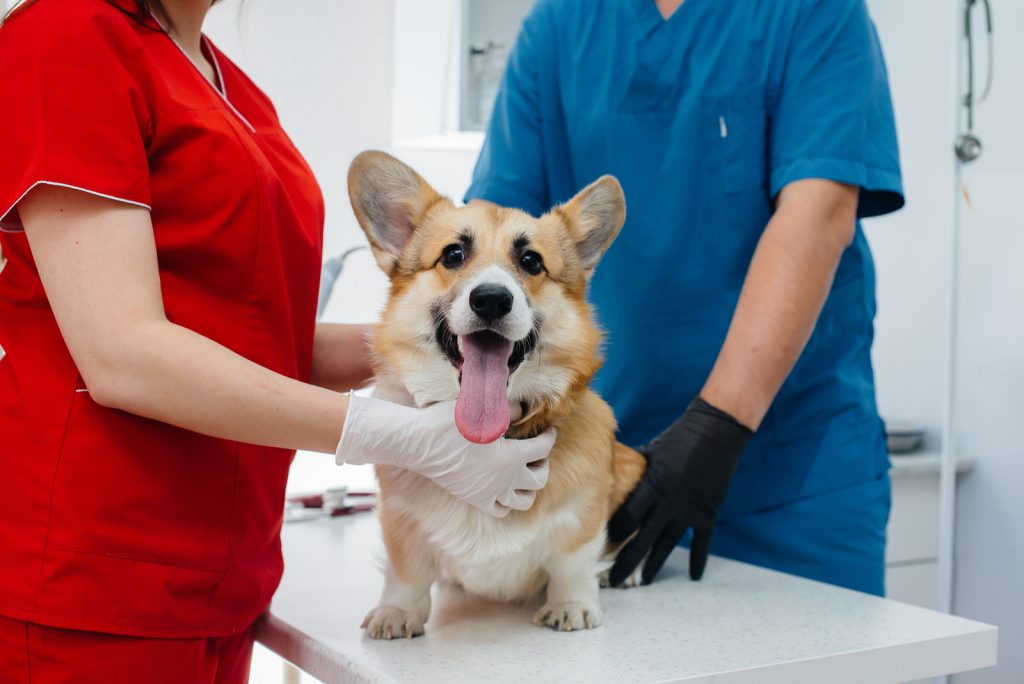
Ultimately, do not wait for your dog’s crusty scabs to worsen. See a vet as soon as you notice itchiness or scaly skin in your dog! Dog owners should not ignore skin issues like this by no means.
The vet will perform essential examinations, such as skin biopsy, allergy testing, or skin scraping. After that, the vet will prescribe the treatment following the cause of the skin irritation.
If your dog has a nutritional issue, your vet will probably prescribe a change in the dog’s diet.
If there is a bacterial infection, your dog will be prescribed anti-bacterial cream or ointment.
In any case, do not hesitate to go to the vet. The sooner you do this, the sooner your pooch will start to feel better.
Summary
We have learnt that crusty scabs on dogs back can indicate various health conditions. In any case, dog owners should take these changes in the dog’s skin seriously.
The treatment might be straightforward and your pooch will recover within a few days. However, it is, unfortunately, possible that it is a much more severe health problem that will require more extended treatment.
Therefore, no dog owner should decide on the treatment on their own. What you can certainly do is take care of regular bathing and brushing of your dog.
Also, ensure that your dog’s area is always clean and that the food it eats is of high quality.
Leave everything else to your veterinarian and you will be sure that you are taking the best care of your dog’s health.
Read Next:
• What Could Crusty Scabs Around Dog’s Mouth Mean? 9 Explanations
• 11 Reasons Why Dog Keeps Licking Lips & Tips How You Can Help
